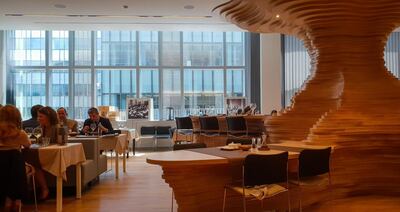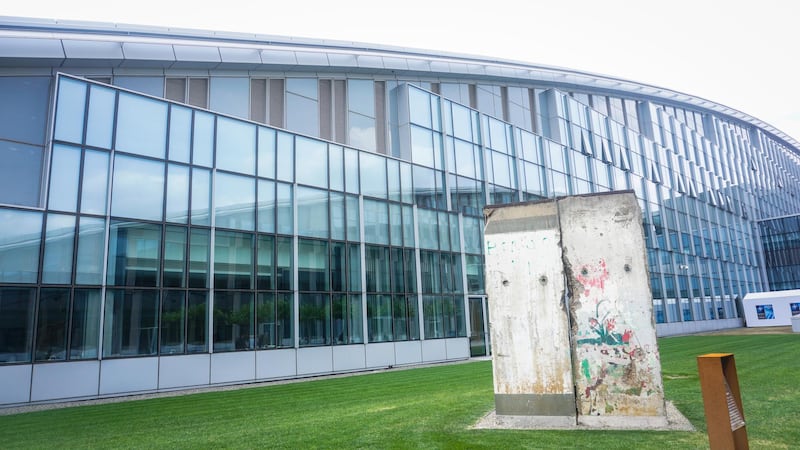Inside the lobby of Nato's US$1.45 billion (Dh5.33bn) headquarters, a sculpture of Roman emperor Domitian’s departure to defend the borders of the empire in 83AD sits against a wall. Almost 2,000 years later, leaders of the world's biggest military alliance have left their home countries and headed for Brussels to defend itself from within.
The shiny, modern headquarters, built after two decades of planning, evaluation and delays, is a new home for an alliance that is facing problems, both young and old.
As Nato's annual summit opens on Wednesday, questions are again being asked in Washington about the alliance's European members and their contribution to defence spending.
Allies of the United States in Brussels are preparing for a more aggressive, more demanding president who they fear could tear the 69-year-old transatlantic alliance apart over who pays the bills.
"The Europeans are petrified," the renowned European military scholar Jolyon Howorth told The National.
__________
Read more from Jack Moore in Brussels:
Nato Summit: The key issues on the table for alliance
Europe aims to avoid disaster as Nato prepares for a Trump tornado
__________
The alliance – which Moscow has long termed a "Cold War relic" – has an opportunity at the summit to show that, like its headquarters, it can change with the times and address challenges facing the modern world: terrorism, migration, cyber-crime and an emboldened Russia.
The building, which hosts a section of the Berlin Wall and wreckage from the 107th floor of one of the Twin Towers (the World Trade Centre) struck in the September 11 attacks in 2001, is a reaffirmation of the members' commitment to the alliance and the values they share. It will be the first time that the 29 Nato members and their embassies host a summit in the new nerve-centre that US President Donald Trump inaugurated at a ceremony last year.
"I never asked once what the new Nato headquarters cost," Mr Trump said of the glass structure at the May 2017 event. "I refuse to do that, but it is beautiful."
The property and hotels magnate should have asked, because the figures are staggering. The architecture, design and quality management of the building cost $129 million alone. The actual construction costs – $514bn – accounted for about half of the total expense.
The building was completed in mid-June, a year later than planned, and holds about 4,200 Nato employees from military and diplomatic sections within its confines.
Developers could not build upwards, because of Belgian building regulations, so it is spread out and stands at only 32 metres in height at its tallest. Sprawling roads around the complex are lined with bicycle lanes for those who want to navigate Belgium’s notoriously flat terrain.

Officials say they had to move. The alliance was previously housed in a stale headquarters – dubbed a prefab – located just across the road. It was built in 1967 and even had rainwater leaking into the offices of the alliance's top officials. Compared to the new headquarters, the old premises were built in a rush after France's departure from the alliance's military command in 1966, when they had to leave Paris.
"It is a symbol of Nato's transformation for the 21st century," says one of its officials, who asked not to be named, yet talked up a "new, environmentally-friendly building able to accommodate Nato's changing needs".
The language of the alliance is bureaucratic, but the steel and glass of its building is strikingly futurist. At first glance it looks like a large airport terminal, or as if a Eurostar train is about to appear from behind its transparent walls. A more unflattering comparison by a summit delegate likened it to a "massive Chinese factory".
Once through airport-like scanners, the centre caters to the many needs of its busy occupants. It hosts a live-in barber, a dry cleaners, and the largest Starbucks in Belgium (which they are proud of here). Fuelling Nato's delegation is a restaurant called "Diplomat".
The expected crowd of ambassadors, aides and attachés – whose languages range from French to Dutch and English – talk shop as they clink wine glasses and tuck into high-end duck and pork.
Looking from within, one can imagine Nigel Farage and his fellow European populists railing against the building and all it holds.
Briefing rooms look like they have been plucked out of a James Bond film. Translators sit behind dark glass, while a large Nato logo – a white compass rose emblem – looms over attendees on a big screen. It feels like a boardroom at a military corporation rather than a multilateral body.
Whatever the new building's cosmetic innards, it will be concrete actions – or the lack of them – around the table that count in the next few days.
The route to the headquarters is lined with Belgian flags hanging from apartment balconies in support of the country's national team, who faced France on Tuesday night in a World Cup semi-final. But inside the new building, there will be a more important, transatlantic game at play.
By the end of the summit, and when Mr Trump departs, the Europeans within this ostentatious building may wonder if they should have been more forthcoming with funds for Nato defence spending earlier, and more readily.
The worst outcome for those here would be a stunning headquarters with one of the 29 flags that flutter outside its extravagant structure, the US Stars and Stripes, lowered for good.






